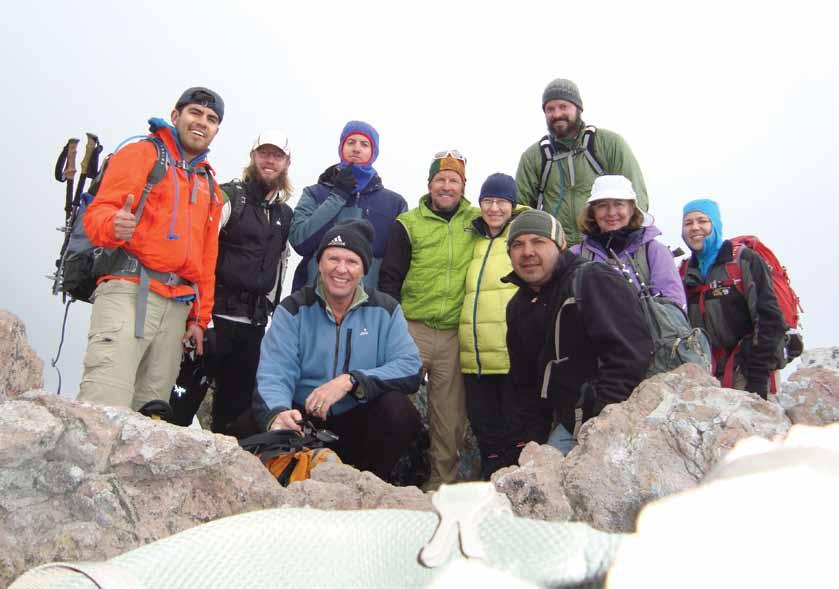
11 minute read
12 CliMbers, 8 Days, 4 Peaks, 1 CleanuP
12 Climbers, 8 Days, 4 Peaks, 1 Cleanup, and a Little Tequila…
By Dave Covill with Roger Wendell
Summit of La Malinche. Photo by Dave Covill
In mid-January the CMC sponsored an Adventure Travel trip to climb the Mexican volcanoes. This High Altitude Mountaineering Section (HAMS)-level trip was led by Dave Covill and Tom Chapel, from January 11–19, 2014. The group trained for this trip, climbing Pikes Peak, Grizzly and Torreys (from Loveland Pass), Quandary, and other winter routes. Most participants were graduates of HAMS classes taught by the CMC. The CMC was well represented with climbers form the Fort Collins, Boulder, Denver, Colorado Springs, and San Juan Groups. Leader Dave had been to Orizaba before, as had Lake City climber Patrick, but not to any of the other volcanoes, so this was to be a chance for all to visit some new ground.

Our roster consisted of seven mountain men and five mountain women: James Graham, Patrick Kelley, Tom Chapel, Keir Hart, dustin Steffenson, Jorge Gonzalez-Calvillo, Natalie Moran, Margaret Turner, Kelly Greaser, Laurance desmaris, daedra Pierce, and dave Covill. About half had climbed high before, and the others were looking to establish new personal altitude records.
We flew American Airlines through dallas on a Saturday and on to Mexico City, where we were whisked away immediately by shuttle van drivers Antonio and Joel to Tlachichuca (Tlach), at the base of Orizaba, the 18,500-foot highpoint of Mexico, and third highest peak in North America. Our route provided great views of the Colorado Front Range peaks, then the Gulf Coast seashore in Texas, and finally the high volcanoes, our destination. ***
We were hosted by the Canchola family in Tlach. Their bed and breakfast for climbers is a distinct contrast to the other outfit in town, operated by Senor Reyes, which is more European-styled, with platform bunks and cooking tables. The Cancholas have an eight bedroom motel-style compound, with a dining room where they serve breakfast and dinner. They are the only people who can supply canister gas for non-white gas stoves. We appreciated the hospitality of Joaquin Canchola, daughter Maribel, and the entire family, who made us feel right at home by immediately saying, “Help yourselves to the cerveza in the refrigerator….” Of course, we did so immediately upon arrival. It turns out they count the empty bottles to bill you later; what a concept! Maribel gave us cooking lessons during our time there, including mole for enchilada sauce, and salsa verde, her specialty.
Sunday is Market day in Tlach, so we all accompanied Maribel through the closed-off town streets where hundreds of vendors were plying their wares: clothing, music, food, and beverages. We stocked up on fresh fruit and veggies, cheese, and meat and tortillas, and soon we were headed up the long, rough road to Orizaba in 4Wd trucks, all of them older than our youngest climber. Just when we thought we would have to beg for a potty break, we arrived at the Piedra Grande Hut at 14,000’, just above timberline. This hut has platform bunk space for maybe 60 climbers, but not us; we had brought our own tents. We set them up a hundred feet higher than the hut, and went off on an acclimation hike. I had originally thought we would be satisfied going to around 15,000’ (or lower), but not this group. No, the group kept going to the base of the Labyrinth, an icy steep section at about 15,500’ where the approach ends and the real mountain begins. Here the scree stops and the snow starts, and it’s time to crampon up if going higher.
The next day we slept in, and then hiked to the top of the Labyrinth at about 16,200’. Natalie wanded the route downward, and we each brought group gear and water to stash in duffels at the base. Jorge, who lugged over three liters of water to cache, was our primary Spanish speaker, having grown up in Mexico. James and I were also reasonably fluent, so we had a very easy time communicating. It is possible to camp here or even higher up top, but this is a cold, dark, desolate place, and the snow would be difficult to melt for water and would taste horrible. We were committed to a 4,500’ day hike from the hut, but making a cache helped on summit day.
I had arranged for the Cancholas to drive up and create a dinner spread for us, unbeknownst to the gang. When we came down from our cache and acclimation run, the group was delighted to learn that freeze dried meals were not on the menu; Maribel had chicken soup, rice, bread, and other treats!
We had made arrangements to hire local Mexican guides and tent guards, and met them at that point. Lead Guide Vicente Azpeitia has climbed Orizaba about 100 times, and Ixta about 300 times. (There
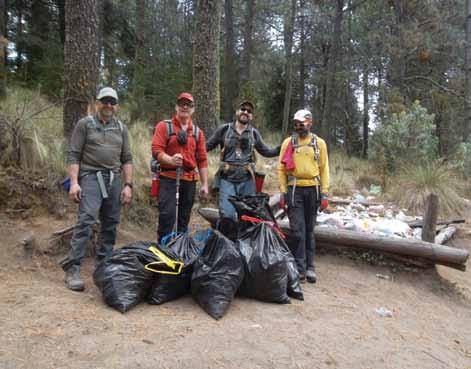
La Malinche cleanup during the March Mexico trip. Photo by Roger Wendell
Atop Pyramid of the Sun. Photo by Dave Covill
aren’t a lot of different peaks down there that folks want to be led up, so Azpeitia tends to repeat a lot of climbs.) Our need for guides was almost entirely to escort slower climbers or help someone down who wasn’t on their A-game that day. We all decided that paying guides was well worth the minimal cost. The Cancholas took down a climber who was suffering from mild AMS, who recuperated immediately upon arrival in Tlach, and performed well on the other peaks.
The 3am wakeup call seemed early, but we had clear skies with almost calm wind and about 25-degree temps at the hut. The headlights spread out naturally, as there was no way to herd cats on a dozen climbers with widely varying speeds. Tom, dustin, Keir, and other faster climbers led us up. Soon we all gathered at the cache and divvied gear, and the faster climbers headed us up. dawn broke with the sun rising on our left as we climbed southward up the north slopes of Orizaba.
Once above the Labyrinth gully, we began to sense that the calm below did not translate into ideal conditions above. Once we were on the open snow at 16,200’, we were treated to temps closer to 20 degrees, with a steady 20-25 mph wind from the west, to our right. Once we were well up on the upper slopes, at about 17,500’, the faint trail became more well-used, and began to switchback left and right. We welcomed the zigs to the left, cursed the zags to the right into the wind, and broke onto the crater rim close to the summit into a relative calm. The crater itself is impressive, perhaps a half mile across, and about that deep. My summit shot has Kelly, Margaret, Laurence, and others sharing the warm south-facing ash in a sheltered nook with me. After a few group photos and lunch we headed down, content that we had made the summit of Orizaba, our primary goal of the trip. We passed by a steep narrow chute in the Labyrinth, and Vicente quietly noted that this was the spot where the young American climber had perished a week earlier in a fall. ***
Wednesday was a scheduled rest and recreation day, and a half dozen climbers headed with Maribel to tour the cathedral and markets of Puebla, a city of three million an hour to the west, Mexico’s fourth largest and noted for being the home of “mole,” a dark sauce that usually accompanies enchiladas. The rest chose to climb Sierra Negra, a 15,100-foot sub-peak of Orizaba, with a huge radar dish on the summit. This peak has well over a thousand feet of prominence, and is the fifth highest in Mexico. We regrouped back at the Canchola House to inflict damage upon livers and reputations. Many bottles were also harmed, or so I was told….
Thursday we travelled two hours northwest of Puebla to La Malinche, 14,600’, the sixth highest peak in Mexico. The trailhead at 10,200’ is gated with rangers and a small store. We trudged up the usual dirt path straight uphill, crisscrossing with a road to a small radio tower. We were astonished to see all the trash, not present in such quantities at the more popular Orizaba and Ixta National Parks. Glass, plastic, wrappers, you name it, it was everywhere. We broke out of the trees and spread out to make our way to the summit ridge. A final 30-foot Class 3 section found nine on top at once, a real treat.
I gathered the group and asked, “Who has any plastic bags, any size?” We came up with a half dozen Safeway bags, and I promptly dug deep into my pack to my seldom-used “10 Essentials” bag, and found two large black plastic leaf bags I keep for emergency bivy purposes. “Who wants to do a cleanup?!?” We had unanimous participation within seconds, and soon we were cleaning up every scrap on La Malinche as we descended, except the ubiquitous orange peels, and of course white TP. We were able to completely clean the mountain down to the 12,000’ level, and we carried all the bags to the rangers below for disposal. Guide Vicente was in tears, and said it was the coolest thing he had ever seen. He was astounded that Americans would take care of his playground, and expressed dismay for his fellow countrymen, who so often take the cleanliness of the land, water, and air for granted. It felt good to do something positive and make an impact, at the cost of an
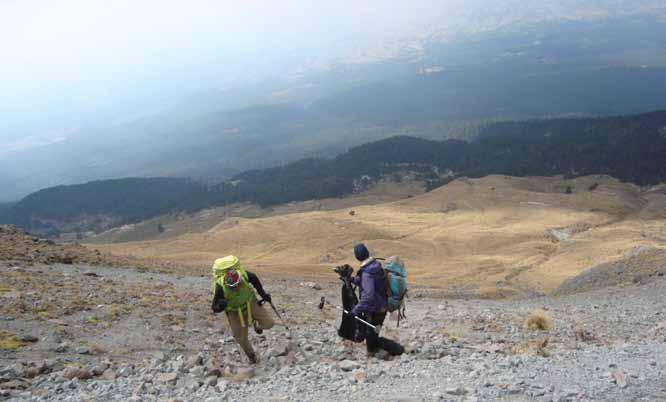
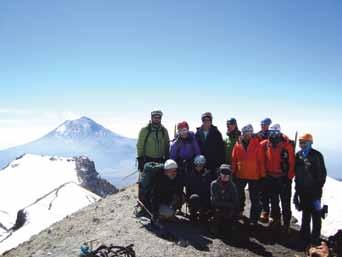
La Malinche cleanup. Photo by Dave Covill
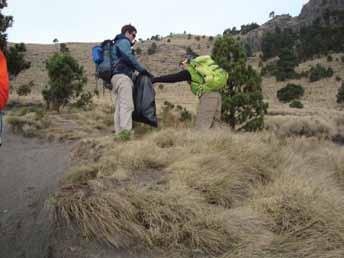
extra hour to the trucks.
Ixta, a 17,100-foot peak and the third highest in Mexico, was next up. We camped at the trailhead the night prior (Friday) in a huge dirt parking lot, which we had almost to ourselves. up and hiking by 4 a.m. again, this was a very long hike, requiring more physical effort than Orizaba, with lots of ups and downs. Ixta is known as the Sleeping Lady, and indeed if you observe her from Mexico City, you can easily imagine her: up and over the Feet, the Knees, across the snows of the belly, to the Chest. Ixta has maybe six thousand feet of total gain, over about seven miles one way. (Compare this to Orizaba,which has no ups and downs, and is maybe three to four miles one way, 4,500’ straight up.) Ixta has a nasty 1,000-foot-plus scree slope, and snow up high to cross. Ten of us summitted, and it was our most on top at one time. Ixta has some controversy as to which of three points on the flat summit crater rim is the actual highpoint. We determined the actual summit (there is some controversy on summitpost.org’s trip reports) to be the southeast spot; the southwest is 10 feet lower, and the northeast is three feet lower and half a mile away. I had my trusty 5X power hand level along for this reason.
It’s a cool climb; once up on the ridge you can look east to Puebla and west to Mexico City in the dark and see city lights, with Orizaba visible a hundred miles to the east once daylight comes. Mexico City air pollution is horrendous, and we were glad that it seemed we had climbed up out of the smog and we felt like we were above it. To look down ten thousand vertical feet westward into a city of 23 million was also a treat. It’s hard to imagine a similar view near any other city that size. We passed by about 300 Mexicans on their way up on Saturday, some in sneakers and clutching a single water bottle. Most seemed intent to spend a night halfway up, a real treat for city-folks, I am sure. Twenty miles south, Popo, at 17,400’ and Mexico’s second highest peak, puffed smoke at us the entire trip. It has been off-limits to climbing since 1994. Will it ever be visited by any of us? Stay tuned.…
We spent the night in Amecameca, an eastern suburb of Mexico City, and enjoyed a fine dining experience at a nice restaurant. Sunday we drove across the metro area to the Pyramids, breakfasted there, and climbed the Pyramid of the Sun and the Moon, the third and fourth highest pyramids in the world after the Great Pyramids of Egypt. The Aztec culture was impressive to observe, and we learned a great deal about the ancient ones and their uses for obsidian and yucca plants. *** demand for this trip was sky-high, and the CMC Adventure Travel Committee authorized a second trip with an identical itinerary, led by Roger Wendell on March 1. He lined up another dozen participants, and they headed south with many garbage bags to finish the La Malinche cleanup. Their trip consisted of Mike Price, Matt Klimock, Mark Silas, bruce Miskulin, Zach Randall, bruce Randall, Matt diPaolo, Charles Cummings, david bower, Kevin Willey, Chris Kimmet, and Roger Wendell.
The group had issues with transportation but overcame them to succeed on the four peaks. Most participants were able to summit at least two of the peaks. They enjoyed good weather and great food, like the first trip. △




